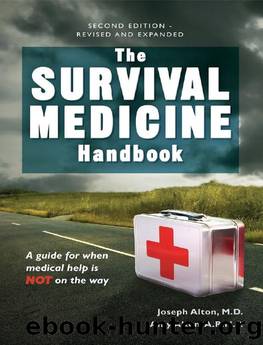The Survival Medicine Handbook: A Guide for When Help Is Not on the Way by unknow

Author:unknow
Language: eng
Format: epub
Tags: Medical, Emergency Medicine
ISBN: 9780988872530
Google: OoY8nwEACAAJ
Amazon: 0988872536
Publisher: Doom and Bloom
Published: 2013-01-15T07:26:54.767465+00:00
The preparedness community is concerned about the possibility of various calamities. Economic collapse, solar storms, global warming, and civil unrest are just a few. There is one scenario, however, that few consider as a possible cause of a long-term survival situation: biological warfare.
Biological warfare is the term given to the use of infectious agents such as bacteria, viruses, fungi or their by-products to wreak death and havoc among a specific population. As a result, the user achieves control over an area or a segment of the population by weakening the ability to resist. Biological weapons donât necessarily have to kill humans: unleashing a horde of locusts to destroy crops or agents that kill livestock can be just as effective.
This type of weapon has been used since ancient times, and even appears in the bible as part of the plagues visited upon Pharaoh by a wrathful God.
Medieval accounts of Bubonic plague-ridden corpses catapulted into besieged cities abound; this method was used as late at 1710, when the Russians attacked the Swedish city of Reval (present day Tallinn) in this manner.
The Western hemisphere was changed forever by inadvertent introduction of smallpox into the Native American population, killing 90% in some areas and opening vast swaths of land for European colonization.
In addition, purposeful biological warfare occurred against Native Americans when the British presented a large âgiftâ of infected blankets as a âpeaceâ offering
during Pontiacâs War in the mid-1700s.
As time progressed, new methods and infectious agents (Anthrax) were used in certain situations during World War I. As a result, use of biological weapons was banned by the Geneva Protocol in 1925, but research and production was still carried out by both sides during World War II. Research into the use of Anthrax by the United Kingdom left their laboratory area in Scotland contaminated for the next five decades.
In 1972, the storage, production, and transport of biological warfare agents was banned by the Biological Weapons Convention (BWC). Despite this, there are a number of violations that have been documented in the former Soviet Union and Iraq, and various others suspected. As of 2011, 165 countries have signed the BWC pact.
The perfect biological weapon would have these characteristics:
Be infectious and contagious in a large
percentage of those exposed.
Cause severe long-term debilitation or death of the infected organism.
Have few available antidotes, preventives or
cures.
Be easily deliverable to the area or population targeted.
Have low likelihood of causing damage to
those using the agent.
The concerns about âaccidentsâ affecting the aggressor have most countries reluctant to use such weapons in normal tactical situations. During the largest such accident in 1979, a Russian lab released anthrax into the surrounding area, killing 42 people, infecting sheep over 200 miles away, and causing the immediate area to be off-limits even today.
Some candidates for use as biological agents include Anthrax, Smallpox, Viral hemorrhagic Fevers (Ebola, etc.), and Pneumonic Plague.
Anthrax can be contracted in several ways, by skin contact, inhalation, and gastrointestinal infection. More common in livestock than people, Anthrax is not an ideal
âweapon of mass destructionâ in that no person-to-person contagion occurs, except in skin cases (the least lethal form).
Download
This site does not store any files on its server. We only index and link to content provided by other sites. Please contact the content providers to delete copyright contents if any and email us, we'll remove relevant links or contents immediately.
When Breath Becomes Air by Paul Kalanithi(7274)
Why We Sleep: Unlocking the Power of Sleep and Dreams by Matthew Walker(5657)
Paper Towns by Green John(4178)
The Immortal Life of Henrietta Lacks by Rebecca Skloot(3833)
The Sports Rules Book by Human Kinetics(3597)
Dynamic Alignment Through Imagery by Eric Franklin(3499)
ACSM's Complete Guide to Fitness & Health by ACSM(3472)
Kaplan MCAT Organic Chemistry Review: Created for MCAT 2015 (Kaplan Test Prep) by Kaplan(3429)
Introduction to Kinesiology by Shirl J. Hoffman(3305)
Livewired by David Eagleman(3133)
The River of Consciousness by Oliver Sacks(2998)
Alchemy and Alchemists by C. J. S. Thompson(2917)
The Death of the Heart by Elizabeth Bowen(2909)
Descartes' Error by Antonio Damasio(2744)
Bad Pharma by Ben Goldacre(2735)
The Gene: An Intimate History by Siddhartha Mukherjee(2500)
Kaplan MCAT Behavioral Sciences Review: Created for MCAT 2015 (Kaplan Test Prep) by Kaplan(2494)
The Fate of Rome: Climate, Disease, and the End of an Empire (The Princeton History of the Ancient World) by Kyle Harper(2443)
The Emperor of All Maladies: A Biography of Cancer by Siddhartha Mukherjee(2438)
